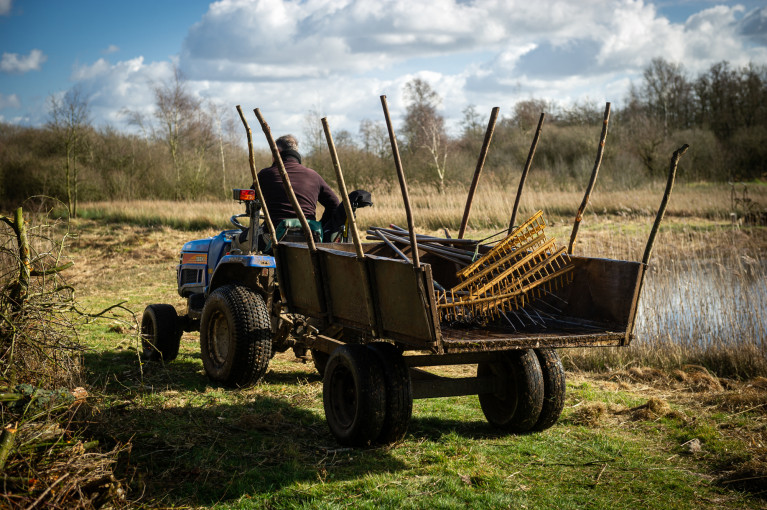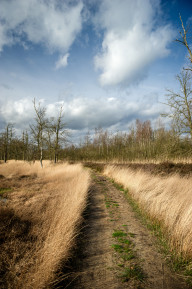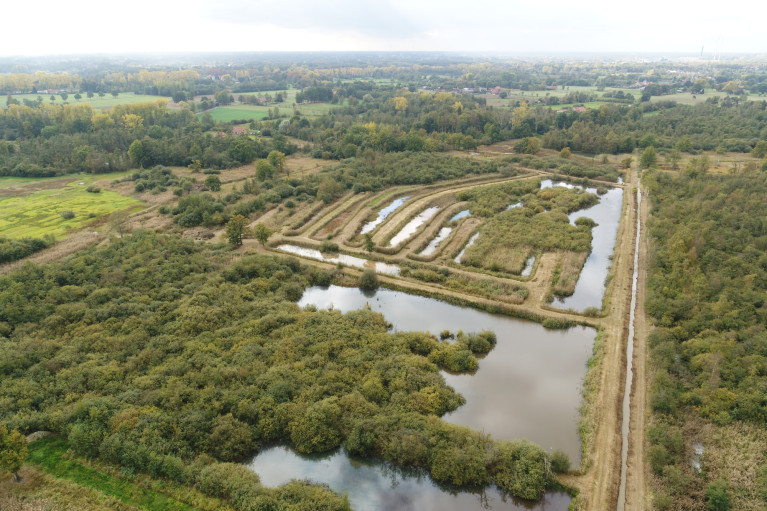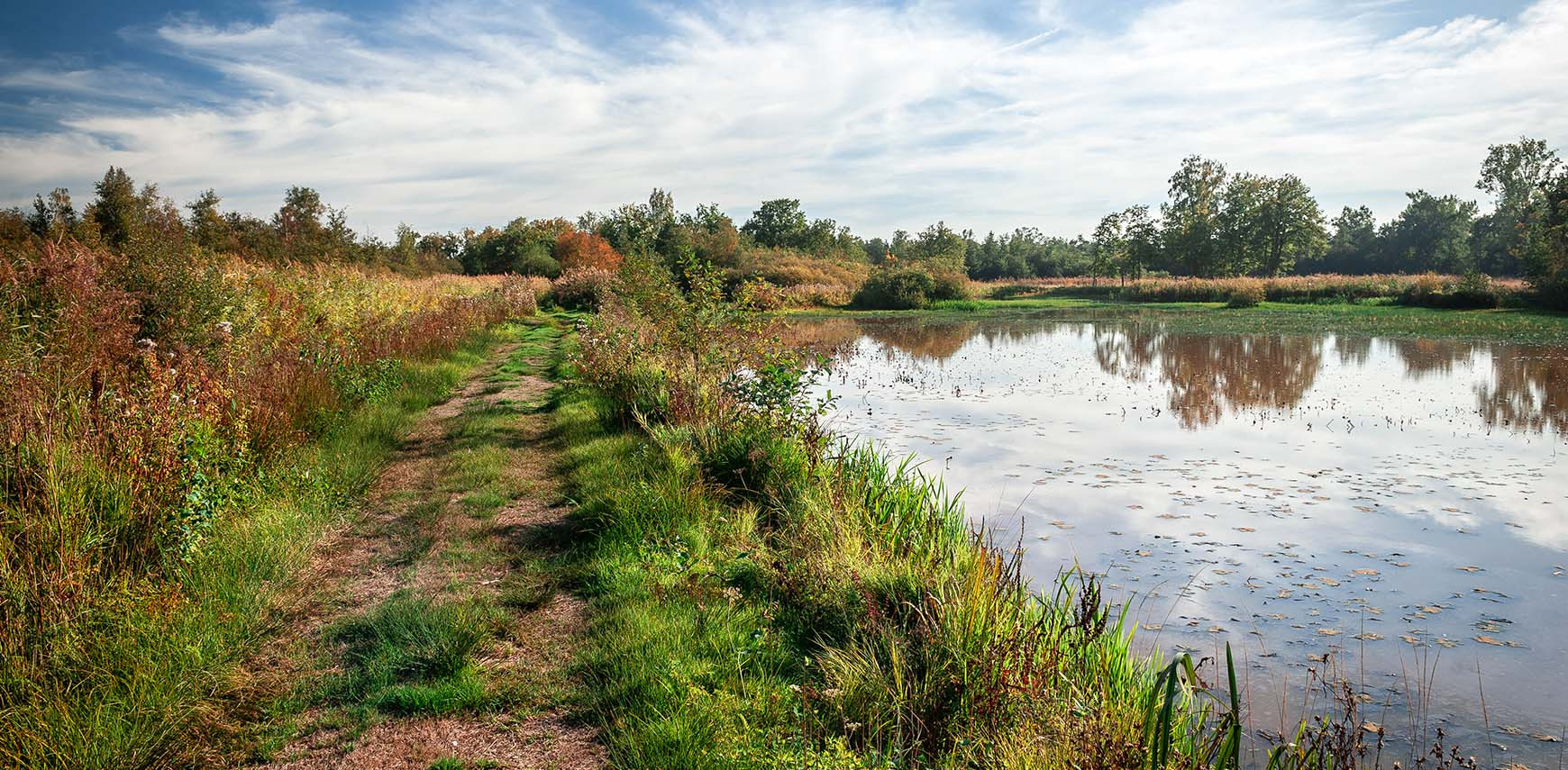A good net balance of greenhouse gases? De Zegge as a storage facility
The science division of Antwerp ZOO is conducting research into the emission of greenhouse gases, such as carbon dioxide (CO2) and methane gas (CH4), in the De Zegge nature reserve in Geel, Belgium. ‘Not only is De Zegge the oldest nature reserve in Flanders, but it is also one of the few places in our country where large amounts of living peat can still be found in the soil. Peatlands are a perfect – both active and passive – storage facility for CO2. Conservation of this area is therefore of crucial importance, as is our awareness of its impact on greenhouse gas emissions’, explains Willem-Jan Emsens of the Antwerp ZOO Centre for Research and Conservation (CRC). To arrive at scientifically founded statements concerning this phenomenon, he is measuring the emission of greenhouse gases at twenty different locations throughout De Zegge. By repeatedly taking these measurements for the duration of an entire year, in all seasons, and linking these to meteorological data, researchers can draw conclusions about the net intake and emission of greenhouse gases in this area.
‘Greenhouse gases are gases that occur naturally in the atmosphere. The two best-known are carbon dioxide and methane gas. Another is water vapour. These greenhouse gases are capable of absorbing heat,’ says Emsens, a researcher who has been measuring peat for more than 12 years now. ‘On the one hand, we are grateful for greenhouse gases, because it is thanks to them that we live in a habitable world. If there were no greenhouse gases, it would be too cold here for human survival. On the other hand, we are currently experiencing serious problems as the concentration of greenhouses gases in the atmosphere is increasing too rapidly due to human activity. This is the cause of global heating, which is currently leading to extreme weather phenomena.’
Peat as an active and passive storage facility
Peatlands like De Zegge play a crucially important role in creating a sustainable balance in terms of greenhouse gas emissions. ‘Peat is an outstanding vehicle for the storage of carbon! Plants absorb carbon dioxide, which is then converted into carbohydrates to facilitate the growth of the vegetation – a process better known as photosynthesis. In winter, a part of these plants often dies, both above and below the surface. The dead vegetation subsequently decomposes. However, this process is different in peatlands compared to other nature reserves. Peatlands are always moist and low in oxygen by their very nature. This means that it takes a very long time for dead plant material to be broken down. If the net supply of plant material is greater than the amount broken down, this results in ‘active peatification’. Carbon dioxide is thus actively absorbed into the soil, where it is stored in the form of organic carbon.’
‘Peatlands are a perfect – both active and passive – storage facility for CO2. Conservation of this area is therefore of crucial importance, as is our awareness of its impact on greenhouse gas emissions.’
As most of our peatlands stem from the start of the Holocene Era (10,000 to 12,000 years ago), huge quantities of carbon are now passively stored in the soil. Emsens continues: ‘Hundreds of years ago, a large part of Flanders was still covered by peat in which, on the one hand, a lot of carbon is stored and, on the other hand, kept actively absorbing CO2. In the meantime, 90 per cent of those peatlands have been reclaimed or drained. As a result, our peat is disappearing, active absorption is no longer successful, and a huge net amount of carbon dioxide is being released. De Zegge is one of the few remaining peatlands we still have in Flanders. We owe this to the fact that this nature reserve has been protected for so many years. Here, you will find peat two to three meters deep locally, in which carbon is still stored. It is therefore crucially important that we keep monitoring the condition of the peat and checking to see if the greenhouse gases are still in balance.’
Complex measurements
To get a good picture of the carbon balance, greenhouse gas emissions are regularly measured at twenty different locations throughout De Zegge. The objective is to arrive at a net balance at the end of the year. Is De Zegge, as a whole, still absorbing a net amount of carbon? Or is carbon being emitted because the peat is decomposing too rapidly?
The researcher’s step-by-step method for taking measurements is as follows:
-
A sealed transparent chamber is placed on top of the soil: a cocoon through which sunlight can pass. The chamber is equipped with fans to mix the air and sensors to take constant measurements of the temperature, the humidity and the light intensity.
-
A greenhouse gas analyser is hooked up to the chamber. This device can measure the concentration of carbon dioxide and methane gas, second by second.
-
The analyser is fitted with an air pump that constantly pumps the air through the sealed chamber. This allows the concentration of greenhouse gases in the chamber to be measured every second. This is done for approximately four minutes. By this time, it is clear whether there is a net increase or decrease of greenhouse gases.
-
Now it’s time for an analysis. Thanks to the WiFi connection in the chamber, the data collected here is transferred to the scientists’ laptops instantly for static processing. If the concentration of carbon dioxide decreases in due time, we know that photosynthesis is taking place and that the plants in the transparent chamber are absorbing carbon. Sometimes, however, an increase is detected. This means that the breathing rate of the plants and the soil is higher than the amount of carbon dioxide being absorbed from the air. This results in a loss of carbon at that point in time.
-
These measurements are not taken only once, but multiple times. Emsens: ‘If you want to make an estimate of the net balance of the emissions, it is imperative that you take measurements for an entire year and in every season, both when it is light out and when it is dark.’
-
The data is subsequently linked to meteorological data concerning light intensity and temperature with a view to arriving at scientifically founded statements about the net intake or release of greenhouse gases in that particular year.

Crucially important knowledge
These measurements are important for Antwerp ZOO so that the researchers there can keep a vigilant eye on the condition of the peat in De Zegge. They are also of considerable academic value in general and for the Antwerp ZOO Centre for Research and Conservation (CRC) in particular, which collaborates closely with Antwerp University.
‘The drier peat is, the faster it will decompose, and the more CO2 will be emitted into the atmosphere.’
‘However, the work we do here is, above all, important for policymakers. Politicians are pleading more and more for the inundation of desiccated peatlands. When these inundation projects start, it is of crucial importance that measurements are taken. Only then will we know if our efforts are producing fruitful results,’ explains Emsens.

The Antwerp Zoo Foundation (AZF, the nature conservation foundation that includes De Zegge) hopes to use this scientifically founded information to save the peatlands. The area is facing substantial difficulties, after all. ‘The nature reserve is suffering greatly from desiccation. The peat is relatively dry, much drier than under ideal circumstances. The drier peat it is, the faster it will decompose, and the more CO2 will be emitted into the atmosphere. Partly due to global warming, our long-term need for wetter natural areas is growing, also in and around De Zegge. It is very important that we can identify changes in greenhouse gas emissions immediately thanks to our measurements.’
In the short term, AZF is working to preserve the existing marshland by managing the eco-hydrology to the best of its abilities. This means that it will manage and optimise the way in which water is pumped, moved, used, and consumed in De Zegge. In the long term, AZF wants to convince the farmers in the vicinity of De Zegge to adapt their cultivation methods in such a way to reduce the pressure on the area. AZF is encouraging them to focus on crops that can be grown successfully in wet conditions. This way, their fields can remain partially flooded and they will not have to drain them as profusely. By doing this, AZF wants to sustainably promote the coexistence of the nature reserve and agriculture in the periphery. Only then can De Zegge be saved from desiccation, together with its unique flora and fauna such as the Eurasian bittern, the brown harrier, the spotted crake, the grass snake, and the Eurasian water shrew.
One step further: large-scale measurement research
‘Our emission research is also being linked to research into microbial communities of bacteria and fungi in the soil. When plants decompose, this process is generally driven by larger organisms such as rain worms, which cut the organic material in smaller pieces, as it were. On the other hand, fungi and bacteria are responsible for the complete process of decomposition. In a compost heap that contains large amounts of oxygen, this process occurs very rapidly, but peatlands are environments with very little oxygen and huge amounts of water. Rain worms cannot survive in peatlands, and microbial activity is much slower, thus facilitating the process of peatification.’
‘De Zegge is one of the few remaining peatlands we still have in Flanders. We owe this to the fact that this nature reserve has been protected for so many years.’
This gives rise to an important question: can we use these fungi and bacteria as ‘predictors’ for the emission of greenhouse gases? ‘By taking soil samples as part of our measurements, we can identify the microbes in the soil according to the DNA in the sample (using metabar coding technology). We hope to link the composition of this community of fungi and bacteria to the quantity of methane gas emitted. Little progress has been made in this area internationally, but it could make a world of difference. Greenhouse gas measurements are labour-intensive and expensive, making it difficult to roll out projects like these on a grand scale. However, is we could come up with some kind of proxy, we would be able to pinpoint where and when greenhouse gases are released from the soil on a much bigger scale.’ Want to know more? Read the Science Blog "Peatlands must be rewetted to achieve climate neutrality".


